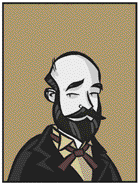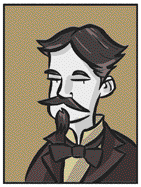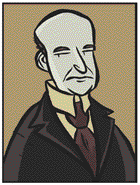
> FAQ | bone wars history
The Real Bone Warriors: A History
O.C. Marsh
Othniel Charles Marsh was born in 1831 and grew up on a farm in upstate New York. Although Marsh's father was not rich, his uncle George Peabody was a very successful businessman, and enabled young Marsh to study at Yale and at several universities in Germany.
In 1866 Marsh returned
to the U.S. and got a position at Yale University. A grant from his uncle
to establish a  paleontology
museum there cemented Marsh's position as a rising po wer i n the field.
With the end of the Civil War and the construction of the transcontinental
railroad, scientists gained access to huge new fossil deposits. The combination
of Peabody's funding and Marsh's own formidable political skill quickly
made the Yale museum a major center for the study of fossils from the
American west. Marsh led four collecting expeditions himself in the early
1870s, and sent out collectors annually after that.
paleontology
museum there cemented Marsh's position as a rising po wer i n the field.
With the end of the Civil War and the construction of the transcontinental
railroad, scientists gained access to huge new fossil deposits. The combination
of Peabody's funding and Marsh's own formidable political skill quickly
made the Yale museum a major center for the study of fossils from the
American west. Marsh led four collecting expeditions himself in the early
1870s, and sent out collectors annually after that.
Marsh also forged an alliance with the U.S. Geological Survey, gaining the position of Chief Paleontologist for the agency in 1882. He served as president of the National Academy of Sciences for more than a decade.
Marsh named nearly 500 fossil species, including the flying reptile Pteranodon, the giant swimming Mosasaur, and the Brontosaurus (now called Apatosaurus). He also described many early mammals, including Uintatherium and some ancestral horse varieties.
He waged a famous and long-running feud with Edward Drinker Cope. They were initially content to work together, but when Marsh pointed out that one of Cope's Elasmosaur reconstructions had the head at the wrong end, a feud began which lasted for decades.
Marsh died of pneumonia in 1899 and is buried in New Haven, Connecticut.
E.D. Cope
Edward Drinker Cope was born to a prosperous Quaker family in 1840. He studied in Europe with the pioneering paleontologist Joseph Leidy. He was a professor at Haverford College and then at the University of Pennsylvania, but financed most of his research out of his own pocket, gradually using up his personal fortune in the process.
Cope was a fantastically
productive scholar, naming more than 1,200 species himself, including
the ancient  reptile
Dimetrodon, the giant Camarosaurus, and the Hadrosaur family. He turned
his home into a fossil warehouse, until eventually he was sleeping on
a cot surrounded by bones. He was President of the American Association
for the Advancement of Science, and editor-publisher of the journal American
Naturalist.
reptile
Dimetrodon, the giant Camarosaurus, and the Hadrosaur family. He turned
his home into a fossil warehouse, until eventually he was sleeping on
a cot surrounded by bones. He was President of the American Association
for the Advancement of Science, and editor-publisher of the journal American
Naturalist.
In 1890, Cope's long-simmering
feud with Othniel Charles Marsh broke into open warfare when the New York
Herald published a long article in which Cope charged Marsh with
plagiarism, taking credit for the work of subordinates, and stealing fossils.
Cope was skeptical about Darwin's theory of Evolution by Natural Selection,
preferring a model based on the theories of Lamarck. He did discover several
important biological principles, including "Cope's Rule." The
journal Copeia is named in his honor.
He died in 1897, and left his remains to science. His skeleton and brain were stored for many years at the Wistar Institute in Philadelphia, and there is a movement afoot to use Cope's bones as the "type specimen" for the human species. His fossil collection is now at the Philadelphia Academy of Sciences.
Charles Sternberg
Charles Sternb erg
was born in upstate New York in 1850, but his family moved to a ranch
in Kansas when he was still a boy. Growing up surrounded by fossil-bearing
rock, Sternberg became an expert bone-hunter. He studied at the Kansas
State Agricultural College (now Kansas State University).
erg
was born in upstate New York in 1850, but his family moved to a ranch
in Kansas when he was still a boy. Growing up surrounded by fossil-bearing
rock, Sternberg became an expert bone-hunter. He studied at the Kansas
State Agricultural College (now Kansas State University).
Sternberg collected for both Cope and Marsh at various times, as well as for the American Museum of Natural History and the British Museum. He preferred to leave writing scientific papers to others, though he did publish several accounts of his work for the general public. Sternberg developed many of the techniques for preparing specimens in the field which are now standard for modern paleontologists.
Sternberg trained his three sons as fossil collectors, and the family's greatest achievement was the discovery of the first dinosaur skin impressions in 1908. One set of Sternberg fossils met an unusual fate: the ship carrying them to England was sunk by a German raider during World War I. A group of divers are investigating the possibility of recovering the fossils after nearly a century on the ocean floor.
Despite spending many summers in rough conditions collecting fossils, Sternberg lived until 1948, and was still doing field work in his eighties.
Barnum Brown
Barnum Brown was born in 1873, and studied at the University of Kansas, but most of his paleontology knowledge was self-taught. Brown began collecting fossils in 1892, and soon became the leading fossil-hunter for the American Museum of Natural History. His discoveries formed the foundation of the museum's collection.
 Brown's
most famous discovery was Tyrannosaurus rex, which he found in 1902 in
Montana. Almost as well-known is Triceratops. Collectors working with
Brown also found important dinosaur trackways and specimens of gastroliths
(dinosaur gizzard stones).
Brown's
most famous discovery was Tyrannosaurus rex, which he found in 1902 in
Montana. Almost as well-known is Triceratops. Collectors working with
Brown also found important dinosaur trackways and specimens of gastroliths
(dinosaur gizzard stones).
Both at home in New York and in the field, Barnum Brown was a fastidious dresser (at times he did his fossil collecting in a magnificent full-length fur coat). Brown was one of the first fossil collectors to recognize the potential of commercial tie-ins. He worked out a deal with Sinclair Oil Company (whose logo was a big green sauropod dinosaur), by which Brown wrote booklets about dinosaurs which were given away at Sinclair gas stations. In exchange, Sinclair funded his expeditions and even let him use company aircraft to scout fossil beds. A friendly rivalry existed between Brown, his teams of student paleontologists, and the Sternberg family. Fortunately, it never became as bitter a fight as the Cope-Marsh feud.
Barnum Brown died in 1963 after a 66-year career as a dinosaur hunter.
